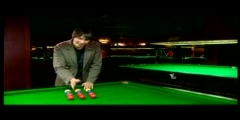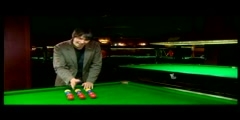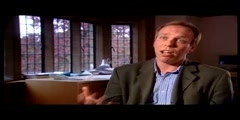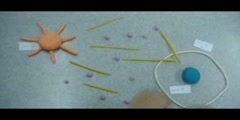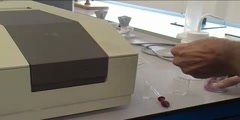Lec 9 - Physics 111: Gamma Ray Spectroscopy (GMA)
Physics 111: Gamma Ray Spectroscopy (GMA) Physics 111 Advanced Laboratory. Professor Sumner Davis This video accompanies the Gamma Ray Spectroscopy Experiment, providing students with an introduction to the theory, apparatus, and procedures. The purpose of this experiment is to measure the mass attenuation coefficients of several materials using gamma ray sources. First you will perform some tests to show the effect of various equipment settings. You will then use the known sources to calibrate your detector, and verify the inverse square law. Finally, you will make some measurements that will allow you to calculate the mass attenuation coefficients for several materials at several energies. In this apparatus, the gamma rays enter a NaI scintillator crystal, which converts them into many lower energy photons. These photons travel through the crystal to the photocathode of a photomultiplier tube, where they are converted into electrons by means of the photoelectric effect. The photo-electrons are sent through a series of electrodes where the number of electrons is multiplied. At the anode, a pulse of current is produced, and then counted. http://advancedlab.org
Video is embedded from external source so embedding is not available.
Video is embedded from external source so download is not available.
Channels: Physics (General)
Tags: Physics 111: Gamma Ray Spectroscopy (GMA)
Uploaded by: berkeleyphy111 ( Send Message ) on 19-09-2012.
Duration: 27m 59s
Here is the next lecture for this course
Lec 3 - Physics 111: Beta Ray Spectroscop ...
41:59 | 3334 viewsLec 24 - Physics 111: Non-Linear Spectros ...
01:01:25 | 4160 viewsLec 25 - Physics 111: Non-Linear Spectros ...
34:46 | 3646 viewsLec 15 - EE290f L Advanced Spectroscopy f ...
01:23:41 | 3884 viewsLec 1 - Physics 111: Atomic Physics (ATM) ...
20:54 | 4501 viewsLec 8 - Physics 111: Compton Scattering (COM)
20:27 | 3816 viewsLec 26 - Physics 111: Atom Trapping (MOT)
35:54 | 3705 viewsLec 1 - New Revolutions in Particle Physi ...
01:54:10 | 3783 viewsLec Last - New Revolutions in Particle Ph ...
01:38:20 | 2892 viewsThe Standard Model of Particle Physics (5 ...
03:07 | 11349 viewsThe Standard Model of Particle Physics (P ...
03:07 | 11541 viewsQED -- The Jewel of Physics (12 of 15)
03:05 | 9245 viewsInfrared Spectroscopy
02:26 | 13780 viewsUV-vis spectroscopy.
03:08 | 5839 viewsLec 1 - Modern Physics: Special Relativit ...
01:49:23 | 4751 viewsNo content is added to this lecture.
This video is a part of a lecture series from of berkeley
Lecture list for this course
Lec 1 - Physics 111: Atomic Physics (ATM) Part 1. Balmer Series
Lec 2 - Physics 111: Atomic Physics (ATM) Part 2. Zeeman Effect
Lec 3 - Physics 111: Beta Ray Spectroscopy (BRA)
Lec 4 - Physics 111: Brownian Motion in Cells (BMC)
Lec 5 - Physics 111: Instrumentation Section Lab Equipment (BSC)
Lec 6 - Physics 111: Bubble Chamber (BBC)
Lec 7 - Physics 111: Carbon Dioxide Laser (CO2)
Lec 8 - Physics 111: Compton Scattering (COM)
Lec 10 - Physics 111: Hall Effect In A Plasma (HAL)
Lec 11 - Physics 111: Holography (HOL)
Lec 12 - Physics 111: Introduction to Error Analysis
Lec 13 - Physics 111: Josephson Junction Effect (JOS)
Lec 14 - Physics 111: Radiation and Laboratory Safety
Lec 15 - Physics 111: Laser Safety
Lec 16 - Physics 111: Atomic Physics (ATM) Theory Lecture ONLY
Lec 17 - Physics 111: Energy Levels Lecture Part 1
Lec 18 - Physics 111: Energy Levels Lecture Part 2
Lec 19 - Physics 111 Light Sources and Detectors Lecture
Lec 20 - Physics 111: Optical Instruments Lecture
Lec 21 - Physics 111: Energy Transitions Lecture Series
Lec 22 - Physics 111: Laser Induced Fluorescence and Raman Scattering (LIF)
Lec 23 - Physics 111: Low Light Signal Measurements (LLS)
Lec 24 - Physics 111: Non-Linear Spectroscopy and Magneto-Optics Part 1 (MNO)
Lec 25 - Physics 111: Non-Linear Spectroscopy and Magneto-Optics Part 2 (MNO)
Lec 26 - Physics 111: Atom Trapping (MOT)
Lec 27 - Physics 111: Muon Lifetime (MUO)
Lec 28 - Physics 111: Non-Linear Dynamics and Chaos (NLD)
Lec 29 - Physics 111: Nuclear Magnetic Resonance (NMR) Part-1 Continuous Wave
Lec 30 - Physics 111: Nuclear Magnetic Resonance Part-2 Pulsed NMR
Lec 31 - Physics 111: Optical Pumping (OPT)
Lec 32 - Physics 111: How to do an Oral Report
Lec 33 - Physics 111: Optical Trapping (OTZ)
Lec 34 - Physics 111: Rutherford Scattering (RUT)
Lec 35 - Physics 111: Hall Effect In A Semiconductor










